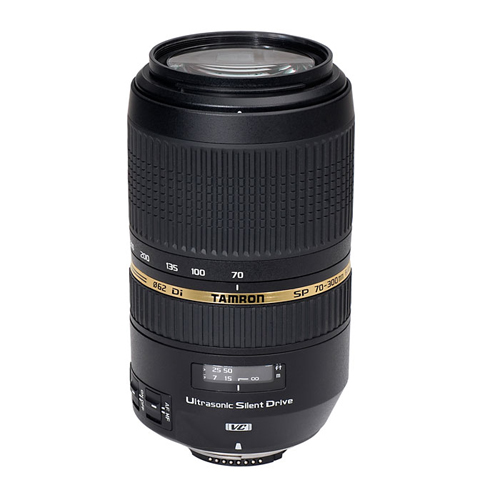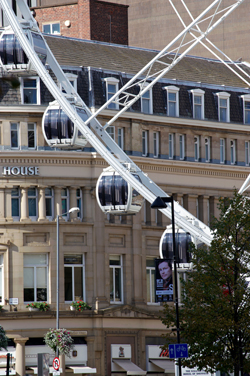Tamron SP70-300mm f/4-5.6 Di VC USD
 |
| Gary Wolstenholme takes a look at Tamron's first lens to include both an Ultrasonic focusing motor and Vibration Compensation. |
Tamron's 70-300mm is a first for the popular third party lens manufacturer being their only lens to date to include a silent ultrasonic focusing motor, which should hopefully provide faster focusing performance than the standard built-in motors included on their other lenses. It also includes a Vibration Compensation system to enable hand-held shooting at shutter speeds lower than would normally be possible. The lens costs around £380 and carries Tamron's SP designation, making the lens one of its top-line optics. This lens is available for use with Nikon and Canon cameras and also Sony cameras, although the Sony version doesn't include the Vibration Compensation system as Super Steady Shot is already included in Sony digital SLRs as standard.
As an alternative, Tamron also offer another 70-300mm lens, which lacks the Ultrasonic Drive and Vibration Correction features, but adds a macro facility for close-up work and is available for around £130.
Canon users have a comparable option in the EF 70-300mm f/4-5.6 IS USM, which also sports a silent focusing motor and image stabiliser for not much more cash, costing around £400. Those with more cash at their disposal may be interested in Canon's EF 70-300mm f/4.5-5.6 DO IS USM, which not only has the Image Stabiliser and USM motor, but is very compact due to the use of a diffractive element in its optical design. This lens isn't cheap though, costing around £1100.
Nikon users also have a 70-300mm with image stabilisation and a silent focusing motor option available in the AF-S 70-300mm f/4.5-5.6G VR IF-ED, which costs a little more at around £410.
Sony users have either the standard 75-300mm f/4.5-5.6 DT lens which lacks a silent focusing motor but costs only £190. The other option is the much higher specified 70-300mm f/4.5-5.6 G SSM which has a fast silent focusing motor and professional level build quality for around £730.
Sigma are the only other third party manufacturer currently offering an equivalent optic. Their 70-300mm f/4-5.6 DG OS lacks the silent focusing motor but has an Optical Stabilisation system and costs around £290.
Tamron SP70-300mm f/4-5.6 Di VC USD: Handling and features
Typical of Tamron's SP line of lenses, it is constructed to a very high standard, with high quality textured plastics used throughout the exterior. Despite the solid build it isn't too heavy a lens; weighing in at 765g and at 142.7mm long, it is a similar size to its competitors.
The zoom ring is located at the far end of the lens and has a nice wide rubberised grip. A quarter turn covers the zoom range and the control has a nice feel to it, offering just enough resistance to avoid zoom creep, but without being too stiff. As this lens has a ring-type ultrasonic motor, manual adjustments can be made to the focus at any time. The narrower focus control is located closer to the camera body, offset by a gold ring that signifies that this is one of Tamron's top-line lenses. A distance scale window is also provided, although no hyperfocal scale is marked. Control switches for autofocus and Vibration Compensation are located on the left side of the lens, which is a typical design for this kind of lens. The switches are larger and protrude more than the controls on manufacturer brand lenses, which makes them easier to adjust if wearing gloves.
Focus is performed internally, so the lens does not extend and the front element does not rotate during focus, making this lens ideal for use with polarising filters. I found the focus speed to be a marked improvement over Tamron's lenses with a standard focus motor, although I did find it didn't feel as quick as some manufacturer's own lenses. Their isn't much in it though and the lens locks onto static subjects quickly and seems able to cope with moderately fast moving subjects too, such as a car driving down a street in a built up area.
Tamron's Vibration Correction system seems to do a decent job of taming camera shake whilst shooting hand-held. I found it possible to get shots at 1/30sec with some degree of consistency at 300mm, which is just over three stops slower than the recommended shutter speed for that focal length.
Tamron SP70-300mm f/4-5.6 Di VC USD: Performance
This new optic from Tamron put in an impressive performance during testing, being capable of producing good resolution in the centre at most apertures and focal lengths. Just as is typical of lenses covering this range the sharpness at 70mm is very good. At f/4 the sharpness in the centre is already very good, improving as the lens is stopped down to f/8 where the lens performs at its peak in the centre. Stopping down to f/11 produces images with excellent sharpness from edge to edge.
Zooming to 135mm reduces the lens' performance a little, but it is still capable of producing images with very good sharpness across the frame. Wide open at f/4.5 the lens is good in the centre and the quality towards the edges isn't too far behind. Stopping the lens down t f/11 produces the lens' peak performance across the frame at this focal length.
Again at 300mm, the sharpness levels decrease a little but the performance is still very respecatable for a lens of this type. Wide open at f/5.6 the resolution in the centre is good and the quality towards the edges is still acceptable. Again the peak for sharpness is found at f/11 where the lens is very good in the centre and good towards the edges of the frame.
By using low dispersion glass in the optical design, Tamron have successfully kept the dreaded effects of chromatic aberrations under control. At shorter focal lengths levels of fringing barely exceed a quarter of a pixel width. At 300mm the level of CA has increased, but is still within acceptable levels, only just exceeding half a pixel width at f/16.
Falloff of illumination towards the corners of the image area is reasonably well controlled. At 70mm the corners of the image are 1.17 stops darker than the image centre at f/4 and visibly uniform by f/5.6. At 300mm the amount of falloff present at maximum aperture increases slightly with the corners being 1.33 stops darker than the image centre at f/5.6. Stopping the lens down just a stop to f/8 results in visibly uniform illumination.
Distortion is well controlled at 70mm with only 0.46% barrel distortion being present. At 300mm pincushion distortion takes the place of the barrelling, with 1.89% barrel distortion being recorded by Imatest. Luckily the distortion pattern is uniform so correcting this in image-editing software afterwards should be pretty straightforward.
| Click on the thumbnails for a high resolution image | ||
 |  | |
| At 70mm this lens is capable of producing images with excellent sharpness across the frame. | At 300mm the lens still performs well. | |
Tamron supply a nice deep petal shaped hood with the lens, which does an excellent job of shielding the front element from extraneous light that may cause ghosting or flare. I found this lens controls flare well, with strong point sources of light in the frame causing a little loss of contrast and flare but no more than you would expect for a lens of this type.
Tamron SP70-300mm f/4-5.6 Di VC USD: Verdict
This new telephoto optic from Tamron has proven itself to be very capable indeed. It is capable of producing images with very good resolution across the image area at all focal lengths and optical aberrations such as colour fringing and distortions are kept well within acceptable thresholds.
The Ultrasonic Drive makes the focusing speed more sprightly than can be found on other Tamron lenses and the vibration correction system was effective during testing.
Overall, I found this lens to be a very good performer representing good value when compared like-for-like with manufacturers' lenses, due to the slightly cheaper price. However, even though it costs less, Tamron haven't compromised on quality, which is commendable.
 |
| This lens is a very good performer representing good value for money without compromising quality. |
 Very good optical performance
Very good optical performance Good build quality
Good build quality Ultrasonic drive
Ultrasonic drive Effective vibration compensation system
Effective vibration compensation systemTamron SP70-300mm f/4-5.6 Di VC USD: Cons
 Focusing a little slower than other silent focusing systems I've used.
Focusing a little slower than other silent focusing systems I've used.| FEATURES |  |
| HANDLING |  |
| PERFORMANCE |  |
| VALUE |  |
| OVERALL |  |
Tamron SP70-300mm f/4-5.6 Di VC USD: Lens specification
| Price | £380.00 |
| Contact | www.tamron.co.uk |
| Filter size | 62mm |
| Format | Full-frame |
| Construction | 17 elements in 12 groups |
| Angle-of-view | 34°21′- 8°15′ |
| 35mm equivalent focal length (on APS-C body) | 105-450mm |
| Internal focusing | Yes |
| Image stabilisation | Yes |
| Minimum focus | 150cm |
| Maximum aperture | f/4-5.6 |
| Minimum aperture | f/32-45 |
| Weight | 765g |
| Size | 142.7 x 81.5mm |
| In the box | Petal shaped lens hood |
The Tamron SP70-300mm f/4-5.6 Di VC USD costs around £380.
Add your message
Login required
Please login here or if you've not registered, you can register here. Registering is safe, quick and free.
Please login here or if you've not registered, you can register here. Registering is safe, quick and free.
photodo Stats
1102 lenses
428 MTF tests
74 in-depth photodo reviews
100+ users join each day
Help the lens community by reviewing or rating a lens today via our lens search
428 MTF tests
74 in-depth photodo reviews
100+ users join each day
Help the lens community by reviewing or rating a lens today via our lens search
Latest Lens Reviews
- Chinon 28mm f/2.8 Vintage Lens Review
- Canon EF 70-200mm f/4L IS II USM Lens Review
- Samyang AF 85mm f/1.4 EF Review
- Sigma 70mm f/2.8 DG Macro Art Review
- Samyang AF 24mm f/2.8 FE Review
- Meike 50mm f/1.7 Review
- Tamron 70-210mm f/4 Di VC USD Review
- Lensbaby Burnside 35mm f/2.8 Review
- Asahi Super Takumar 50mm f/1.4 Review
- Asahi Super-Multi-Coated Takumar 135mm f/3.5 Review






